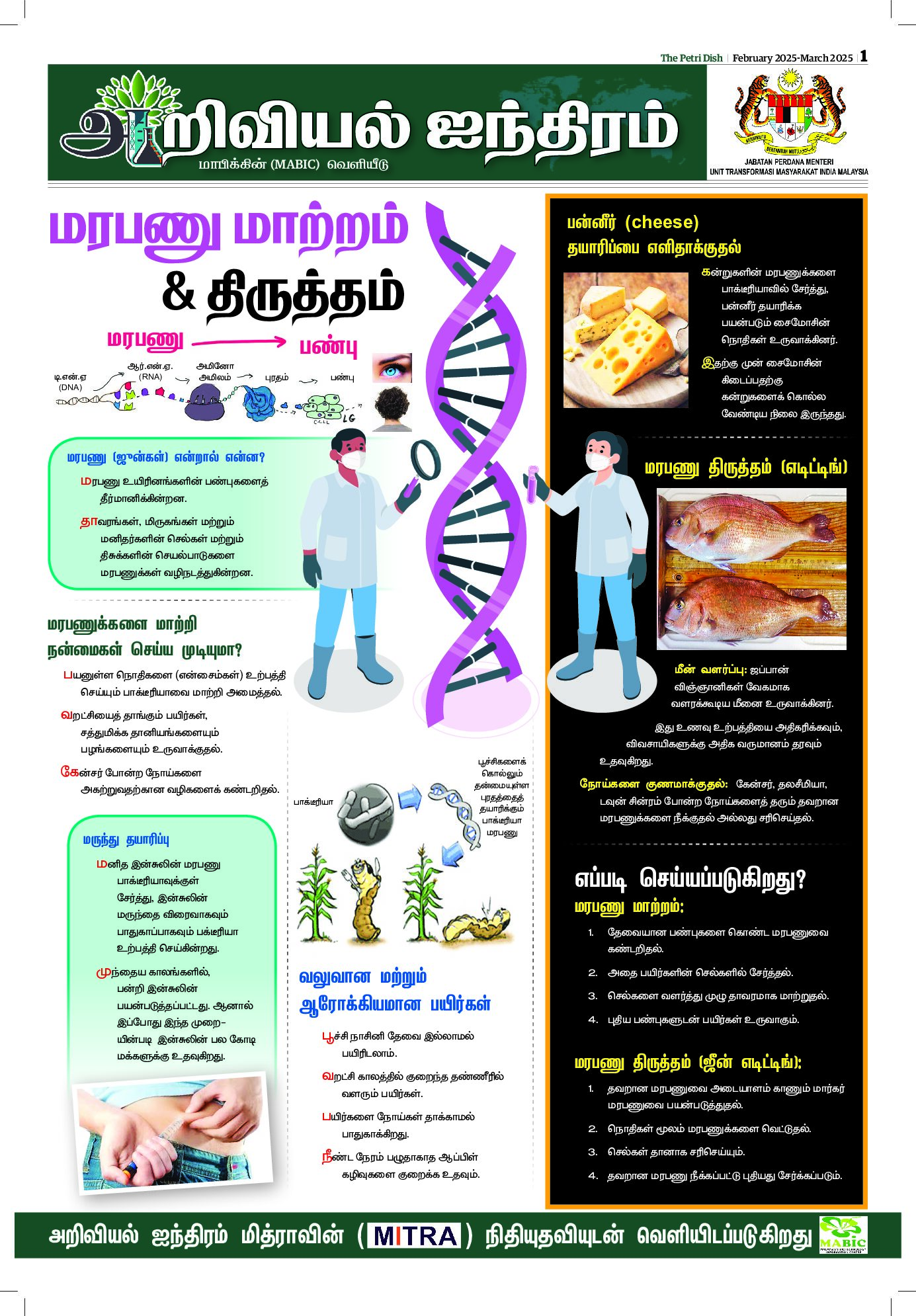BY SAARANI VENGADESEN
THE biggest vaccination programme in Malaysian history is underway to possibly end the current pandemic. However, this does not mark the end of the pandemic yet. To date, only 26% of the population has registered in the “My Sejahtera” app for vaccination, while we need 80% of the population to be inoculated to achieve herd immunity. There is widespread vaccine hesitancy among the public with primary concerns ranging from side effects, long term effects, “halal” issues and safety to high-risk groups among others.
To alleviate public fear and instill trust in order to support government initiatives to attain herd immunity, The Petri Dish and Science Media Centre (SMC) launched YakiniVaksin Campaign. This campaign which is supported by Duopharma Biotech as part of its CSR programme was kickstarted with “Kenali Vaksin Covid-19” Webinar. Streamed live on SMC Facebook, two experts shared their views on most of the common public concerns. Prof Dr Norazmi Mohd Nor an immunologist from Universiti Sains Malaysia and Assoc Prof Dr Malina Osman, a public health specialist from Universiti Putra Malaysia debunked common misinformation among the public.
How effective are Covid-19 vaccines?
“Many question the safety and effectiveness of Covid-19 vaccines as they were developed in a short span of time. The public does not have to worry as no corners were cut. It is the rapid advancement of technologies that made this possible, coupled with unlimited resources, strong international collaboration and availability of a large pool of volunteers for clinical trials,” said Norazmi.
He said that besides the stringent safety tests and clinical studies prior to approval, all Covid-19 vaccines are under surveillance globally which is called Phase 4 trial. Any adverse effects will be reported immediately, shared with all other countries and decisions will be made to address this including recalling the vaccine.
“Around 450 million people have been vaccinated till now and fortunately there are no fatalities due to the vaccine. Even if one gets Covid-19, after full vaccination, the severity of the disease is very low “, highlighted Norazmi.
New additions to the public vocabulary
The bright side of the pandemic is public exposure to many scientific terms such as mRNA, antigen, immunity, spike protein and viral vector. Both experts deciphered some of these terms so the public is not alarmed.
“Like DNA, mRNA is also a hereditary material. It codes for specific proteins,” explains Malina.
“Immunity is a defence or protection against a disease produced by our body. In this context, it refers to immunity towards Covid-19 disease”, said Norazmi briefly. “You either get immunity through actual infection or vaccination,” he further added.
Spike protein are the spikes on the surface of the virus. These spikes can trigger an immune response in our body by producing the antibodies that destroy the virus. This is how Malina described spike protein.
“Antigens are either the full organisms that cause disease or parts of the organisms, such as spike protein. Antigens cause our body to develop antibodies against the particular disease,” explained Norazmi. “So, spike protein is an antigen and it is used to develop vaccines,” added the immunologist.
Norazmi also used an analogy to explain viral vectors. “A viral vector is like a vehicle. We need a vehicle to send viral DNA into our body. In the case of Covid-19 vaccines, scientists are using a virus that is harmless to humans as a vector, the DNA then produces spike protein”, he said.
The types of vaccines
Malina explained the four main ways use to develop Covid-19 vaccines. These are viral vector, mRNA, attenuated virus and protein subunits.
“Attenuated is the traditional way of developing vaccines. The virus is inactivated in a way that cannot cause the disease. This virus is then used as a vaccine to trigger immune response where antibodies are produced”, says Malina.
“Inactivated or live-attenuated is the traditional way of developing vaccines. The virus is either killed or inactivated in a way that cannot cause the disease. This virus is then used as a vaccine to trigger immune response where antibodies are produced”, says Malina.
“mRNA vaccines are those that use part of the viral RNA sequence. The sequence produces the spike protein which then causes the antibodies to be produced,” adds Malina.
Norazmi was quick to add that while many think mRNA vaccines are new, the technology itself is more than 30 years old. “So, there is nothing to fear,” he says.
“In the case of viral vector, the DNA that makes the spike protein of Covid-19 virus is packaged inside a harmless virus. The virus is injected, DNA is delivered, spike proteins are made and antibodies are produced as a result,” says Malina.
Norazmi explained the subunit vaccine were part of the virus that is used to trigger an immune response. The viral vector as explained earlier uses another harmless virus to deliver the DNA that produces spike protein in our body and in turn, causes the production of antibodies.
Do we need so many types of vaccines?
This was raised by the moderator Dr Mahaletchumy Arujanan, who is also the editor-in-chief of The Petri Dish.
Malina shared that the government’s measure not to solely depend on only one vaccine supplier is the right decision. “The government’s effort to achieve herd immunity will be delayed if diplomatic issues occur with the supplying country,” she said.
“The demand is also very high now for Covid-19 vaccines globally. There is no one company that could meet this demand. We need different companies. And the different logistics needs also allows us to choose vaccines according to our infrastructure,” added Norazmi.
Side effects of vaccines, contraindications and comorbidities
Malina explained briefly that side effects are symptoms that are observed after vaccination. Side effects are not only caused by the Covid-19 vaccine but most of the vaccines have mild side effects. “Numbness at the injection site, body aches, slight fever, headache, body fatigue, diarrhoea, and swelling in the neck glands are common side effects,” explained the doctor who specialises in infectious diseases.
“I would urge the public to weigh in the side effects vs the risks of getting Covid -19. The benefits far outweigh the risks,” she added.
The doctor also explained contraindication. This refers to medical situations where vaccines should not be administered. “Individuals with contraindications are not recommended for vaccination”, said Malina. “They will be identified by physicians during health screening. Talk to your doctors and do not make your own conclusions,” she advised.
She was quick to add that the majority of people are safe to be vaccinated.
The term comorbidity describes the presence of two or more diseases in a person such as diabetes, hypertension and cancer.
“Since most of the volunteers in Phase 3 clinical trials are healthy and comorbidity-free, it is advised that cancer patients wait till more data is available on the safety of vaccines for them” Malina explained.
Phases of vaccines testing
Clinical trials and the different phases are also commonly mentioned during the pandemic and the experts explained how these are done.
In Phase 1, small groups of people receive the trial vaccine where its safety is established. In Phase 2, again safety is established but this time the right dosage is also studied. Finally, in Phase 3, a large number of volunteers, usually in tens of thousands are tested,” explains Norazmi who himself works on vaccines.
The Halal issues and herd immunity
“Even the water that is supplied to our house comes from rivers and water sources that have dead animals. But the water undergoes a purification process that makes it safe and also halal for consumption. The same with vaccines as well. They undergo purification and regulatory processes that make it compliant and safe for Muslims,” explains Malina who urges Muslims to go for vaccination.
“As a Muslim scientist, I am not skeptical about the content of the vaccine because to me the vaccine is halal”, echoed Norazmi.
When asked to explain herd immunity, the experts say it is when a large population has immunity either through vaccination or infection. This leaves the virus with no host to attack where slowly the virus will disappear.
Mahaletchumy quickly added that herd immunity is also a way to protect children and others who cannot be vaccinated.
Takeaway messages
When requested for key takeaway messages for Malaysians from the two experts, here is what they said.
“We do not have any alternatives except vaccines to end the pandemic and get back to normal lives,” expressed Malina.
She advised the eligible individuals to register in the “My Sejahtera” App to get their vaccine doses accordingly.
Norazmi also advised the public to register with the “My Sejahtera” app. “Currently there are only 26% registered and we have to increase it to 80% to achieve herd immunity”, he said.
“People should still practice safety measures and all the SOPs even after vaccination till we reach herd immunity” advised Mahaletchumy.
This webinar could be still watched on the Science Media Centre Facebook Page.
Full recording can be watched in Youtube: Kenali Vaksin COVID-19 – YouTube










